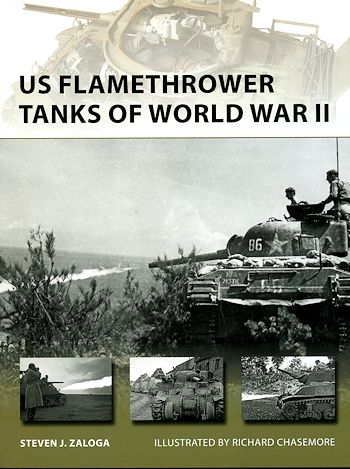 The
flamethrower was developed during WWI and by the second world war, was a staple
in infantry combat, though on a somewhat limited scale. There were issues with
the equipment, and those who carried the flamethrower were quickly targeted by
the enemy once it was used for the first time.
The
flamethrower was developed during WWI and by the second world war, was a staple
in infantry combat, though on a somewhat limited scale. There were issues with
the equipment, and those who carried the flamethrower were quickly targeted by
the enemy once it was used for the first time.
There was also the issue that these did not have all that much range so
the operator had to get fairly close to effectively use it. But it was very
effective as a device of terror as much as it was useful in clearing out
defensive positions that standard weapons were unable to clear.
In order to make it more useful, it was decided to attach it to
motorized equipment. This had the benefit of allowing a more powerful weapon
that could cover greater distance, carry more fluid and offer the folks
deploying it some protection. Ideally, this meant a tank.
However, there were both technical and ideological hurdles to pass. Many
brass did not think it was a worthwhile piece of equipment. There was also the
debate on the method of propellant and what sort of vehicle to use. Initially,
light tanks were utilized with the flame thrower taking the place of the hull
mounted machine gun. However, this meant no close defense gun, though they could
be switched out. There was also the issue of the tanks for propellant and fluid
taking up a lot of room inside the tank. Then there was the tank itself. Light
tanks, such as the Stuart, were not exactly larger nor were they able to
withstand a lot of damage. Even light anti-tank guns would be able to knock one
out and an explosion inside the tank would douse everyone nearby with flaming
fluids.
Despite slow going at home, in the field, conversions were made. This
was pretty well driven by the war in the Pacific. Here, the Japanese were well
dug into caves and well protected defensive positions. It was discovered that
the flamethrower was able to clear out these positions when everything else
failed. In terms of caves, the fire sucked out all the oxygen, killing its
occupants by asphyxiation as much as by the burning fluid itself.
Eventually, through the usual trial and error, a workable solution
presented itself with most set-ups occupying the hull machine gun position,
though later in the war, the flamethrower itself was the main armament, taking
place of the tank's gun. These weapons were extremely successful with the Army
and Marines in the Pacific demanding more and more of these weapons; often
having to share resources.
In Europe, Patton felt they were a waste of time so programs in that
theater stumbled along, not being used very much at all and even then late in
the war. Often times the Army borrowed British Crocodile units to take care of
the lack of flamethrower tanks.
Author Steven J. Zaloga covers the design, development and deployment of these
weapons. This was an area that was rife with ideas, many of which did not
function as planned or was not liked by the soldiers that used it. It is
interesting to note that while flamethrower tanks (most based on Sherman or
Stuart chassis) were used in Korea, they seem to have lapsed into non-use
shortly thereafter. It is a fascinating look at an area of military equipment
that was relatively short lived and not well known by most enthusiasts. Highly
recommended reading.
November 2013
For more on the complete line of Osprey books,
visit www.ospreypublishing.com. In the US, it is
Osprey Direct at 44-02 23rd St, Suite 219, Long Island City, NY 11101., where you can
get a catalogue of available books.
If you would like your product reviewed fairly and
fairly quickly, please
contact
the editor or see other details in the
Note to
Contributors.
 The
flamethrower was developed during WWI and by the second world war, was a staple
in infantry combat, though on a somewhat limited scale. There were issues with
the equipment, and those who carried the flamethrower were quickly targeted by
the enemy once it was used for the first time.
The
flamethrower was developed during WWI and by the second world war, was a staple
in infantry combat, though on a somewhat limited scale. There were issues with
the equipment, and those who carried the flamethrower were quickly targeted by
the enemy once it was used for the first time.